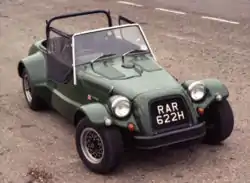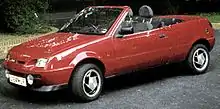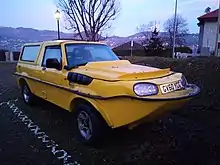Dutton Cars
Dutton Cars, based in Worthing, Sussex, England, was a maker of kit cars between 1970 and 1989. In terms of numbers of kits produced, it was the largest kit car manufacturer in the world.


The company was founded by Tim Dutton-Woolley and run from a small workshop in which a series of cars named P1 were built. In October 1971 the B-Type appeared with a more or less standard specification and based on Triumph Herald components. A move was also made to a larger factory in Tangmere, Chichester.
Products
Most Duttons depended on a ladder frame chassis built from steel profiles, which held the various parts taken from the donor car.[1] After originally using Triumph Herald parts, Most Duttons built used Ford Escort Mk 1 or Mk 2 components.
The B-Type eventually evolved into the Dutton Phaeton. Later versions of the Phaeton were based on Ford Escort components and were produced until 1989. These were also available as fully built-up cars, in which case they received a 1.6 litre Ford Crossflow engine with 84 hp (63 kW).[2]
In 1979 Dutton launched the Dutton Sierra, an Escort-based estate car with off-road looks. Three years later the Ford Motor Company decided to use the Sierra name on their Cortina/Taunus replacement and served Dutton with a legal writ demanding that they stop using the name. But at a case in the High Court in London, Dutton won the right to continue with the name on kit cars, as the judge ruled that they were a separate category from assembled cars.[3] The case was popularly portrayed as a "gritty David and Goliath battle", and provided Dutton with some welcome publicity.[4] The Sierra was Dutton's best seller for many years, production reaching a peak of 22 cars a week. The model was withdrawn in 1989.[4] A further move to larger premises back in Worthing was made in 1982 with glass-fibre body making at a separate works in Lancing.
On the usual rear-wheel drive Ford Escort underpinnings Dutton placed the body of the new Rico. It made its debut in October 1984, at the Birmingham Motor Show. It used the mechanical parts and doors from a two-door Escort but had a Dutton-developed glassfibre body over a steel tubular frame. The Rico was a compact and aerodynamic two-door saloon, 3,911 mm (154.0 in) long and much lighter than the donor car.[5]

By 1984, 80 people were employed spread over four factories and a large showroom in Worthing – production topped 1,000 a year. By 1989 Tim Dutton had got bored with the kit-car scene and all the designs were sold. A new model had been developed called the Maroc, a heavily modified Ford Fiesta with a convertible body. Initially it was available as a factory-finished car but prices became too high and from 1993 kit versions were made available. The design has been sold on to Novus of Bolney, Sussex; availability continued until at least 2006.
After leaving the kit car business Tim Dutton operated as a consultant but returned to the automobile-making business in 1995 with the Dutton Mariner and Dutton Commander, amphibious cars based on the Ford Fiesta and Suzuki Samurai. The Dutton Surf, based on the current Suzuki Jimny, was introduced in 2005. Tim Dutton is now a record holder as the only person to have crossed the English Channel twice in an amphibious car.

Early Dutton kits are now hard to come by. Most Duttons have already been assembled and are only available to purchase as second-hand cars, usually in need of some restoration. When a Dutton is purchased in kit form the person building it will require a donor car. The donor car is used to provide the engine, gearbox and many other essential components. Fords are the most common donor cars, especially for Duttons. Most people use donor cars that would no longer be roadworthy and use the spares to create a new kit car.
Models
| Type | Year | Notes |
|---|---|---|
| Dutton P1 | 1970–71 | Lotus 7 like car based on MG Midget mechanical parts. Aluminium body panels, glass fibre wings. |
| Dutton B Type | 1971–74 | Triumph Herald based. Body mainly made from glass fibre. Ford engine optional. |
| Dutton B Plus | 1974–77 | Rear axle now Ford Cortina but with coil springs. |
| Dutton Malaga | 1974–77 | Front wings moulded in with body. |
| Dutton Malaga B+ | 1975–77 | Malaga front and B+ rear. |
| Dutton Cantera | 1976–77 | Coupé version of Malaga B+. |
| Dutton Phaeton Series 1 | 1977–1981 | Updated Malaga B+. |
| Dutton Phaeton Series 2 | 1980–82 | Rear suspension modified to use Cortina springs. |
| Dutton Phaeton Series 3 | 1981–86 | Modified chassis to use Ford Escort components. |
| Dutton Phaeton Series 4 | 1986–89 | Modified body with integral bumpers. |
| Dutton B Plus Series 2 | 1989 | B+ with Phaeton body style. |
| Dutton Melos | 1981–89 | Phaeton chassis with new body with more rounded styling. 2+2 seat configuration |
| Dutton Legerra | 1988–89 | The first Dutton sports car with opening doors. |
| Dutton Sierra Series 1 | 1980–84 | Ford Escort-based four seater. Estate car/off-road styling. An early, two-wheel drive SUV. |
| Dutton Sierra Series 2 | 1984–86 | Improved body with some double-skinned panels. |
| Dutton Sierra Series 3 | 1986–89 | New body but very similar in styling to Series 2. |
| Dutton Sierra Drop Head | 1983–89 | No roof. Pick-up version also made. |
| Dutton Rico | 1984–89 | Ford Escort-based four seat, two-door saloon. |
| Dutton Rico Shuttle | 1986–89 | Estate car version of the Rico. |
| Dutton Beneto | 1989 | "SUV" styled version of the Rico. |
References
Citations
- Mazzocchi, Gianni, ed. (September 1984). "Per chi vuol farsi l'auto da sé" [For those who want to automobilize themselves]. Quattroruote (in Italian). Milan, Italy: Editoriale Domus. 29 (347): 220.
- Mastrostefano, Raffaele, ed. (1985). Quattroruote: Tutte le Auto del Mondo 1985 (in Italian). Milano: Editoriale Domus S.p.A. p. 263. ISBN 88-7212-012-8.
- Pollard, Tim (27 March 2015). "The CAR Top 10: legal challenges to car names". Car. Retrieved 26 August 2016.
- Chapman (2008), p. 36.
- Tutte le Auto del Mondo 1985, p. 264
Bibliography
- Chapman, Giles (2008) [2001]. The Worst Cars Ever Sold. The History Press. ISBN 978-0-7509-4714-5.
